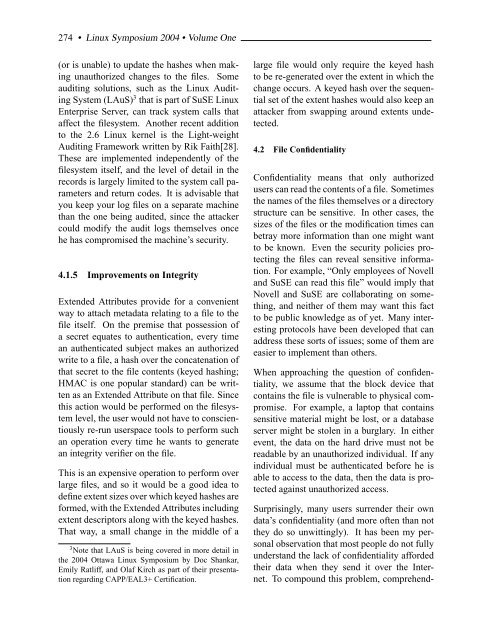You also want an ePaper? Increase the reach of your titles
YUMPU automatically turns print PDFs into web optimized ePapers that Google loves.
274 • <strong>Linux</strong> Symposium 2004 • Volume <strong>One</strong><br />
(or is unable) to update the hashes when making<br />
unauthorized changes to the files. Some<br />
auditing solutions, such as the <strong>Linux</strong> Auditing<br />
System (LAuS) 3 that is part of SuSE <strong>Linux</strong><br />
Enterprise Server, can track system calls that<br />
affect the filesystem. Another recent addition<br />
to the 2.6 <strong>Linux</strong> kernel is the Light-weight<br />
Auditing Framework written by Rik Faith[28].<br />
<strong>The</strong>se are implemented independently of the<br />
filesystem itself, and the level of detail in the<br />
records is largely limited to the system call parameters<br />
and return codes. It is advisable that<br />
you keep your log files on a separate machine<br />
than the one being audited, since the attacker<br />
could modify the audit logs themselves once<br />
he has compromised the machine’s security.<br />
4.1.5 Improvements on Integrity<br />
Extended Attributes provide for a convenient<br />
way to attach metadata relating to a file to the<br />
file itself. On the premise that possession of<br />
a secret equates to authentication, every time<br />
an authenticated subject makes an authorized<br />
write to a file, a hash over the concatenation of<br />
that secret to the file contents (keyed hashing;<br />
HMAC is one popular standard) can be written<br />
as an Extended Attribute on that file. Since<br />
this action would be performed on the filesystem<br />
level, the user would not have to conscientiously<br />
re-run userspace tools to perform such<br />
an operation every time he wants to generate<br />
an integrity verifier on the file.<br />
This is an expensive operation to perform over<br />
large files, and so it would be a good idea to<br />
define extent sizes over which keyed hashes are<br />
formed, with the Extended Attributes including<br />
extent descriptors along with the keyed hashes.<br />
That way, a small change in the middle of a<br />
3 Note that LAuS is being covered in more detail in<br />
the 2004 Ottawa <strong>Linux</strong> Symposium by Doc Shankar,<br />
Emily Ratliff, and Olaf Kirch as part of their presentation<br />
regarding CAPP/EAL3+ Certification.<br />
large file would only require the keyed hash<br />
to be re-generated over the extent in which the<br />
change occurs. A keyed hash over the sequential<br />
set of the extent hashes would also keep an<br />
attacker from swapping around extents undetected.<br />
4.2 File Confidentiality<br />
Confidentiality means that only authorized<br />
users can read the contents of a file. Sometimes<br />
the names of the files themselves or a directory<br />
structure can be sensitive. In other cases, the<br />
sizes of the files or the modification times can<br />
betray more information than one might want<br />
to be known. Even the security policies protecting<br />
the files can reveal sensitive information.<br />
For example, “Only employees of Novell<br />
and SuSE can read this file” would imply that<br />
Novell and SuSE are collaborating on something,<br />
and neither of them may want this fact<br />
to be public knowledge as of yet. Many interesting<br />
protocols have been developed that can<br />
address these sorts of issues; some of them are<br />
easier to implement than others.<br />
When approaching the question of confidentiality,<br />
we assume that the block device that<br />
contains the file is vulnerable to physical compromise.<br />
For example, a laptop that contains<br />
sensitive material might be lost, or a database<br />
server might be stolen in a burglary. In either<br />
event, the data on the hard drive must not be<br />
readable by an unauthorized individual. If any<br />
individual must be authenticated before he is<br />
able to access to the data, then the data is protected<br />
against unauthorized access.<br />
Surprisingly, many users surrender their own<br />
data’s confidentiality (and more often than not<br />
they do so unwittingly). It has been my personal<br />
observation that most people do not fully<br />
understand the lack of confidentiality afforded<br />
their data when they send it over the Internet.<br />
To compound this problem, comprehend-

















